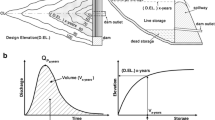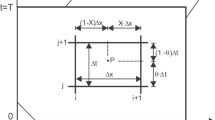Abstract
Reservoir routing is a technique to predict an outflow hydrograph expected from a dam outlet due to a specific inflow hydrograph. This study develops a series of analytical solutions for determining outflow hydrographs with detailed calculation procedures when a triangular, abrupt wave, flood pulse, broad peak, and double-peak inflow hydrographs occur upstream of a typical reservoir with an orifice outlet. The proposed analytical solutions are used as benchmarks to evaluate 16 schemes of a conventional numerical method so-called Runge–Kutta method, and the main equations for sensitivity analyses. The results indicate that the best scheme among those 16 Runge–Kutta schemes is the Kutta–Merson scheme for all types of inflow hydrographs except the double-peak inflow hydrograph in which the Cash–Karp method outperforms others, and the peak of the inflow hydrograph and the water area supplied by the reservoir are the two most sensitive parameters influencing outflow hydrographs results.




Similar content being viewed by others
Change history
15 February 2022
A Correction to this paper has been published: https://doi.org/10.1007/s40996-022-00842-9
Abbreviations
- \(S\) :
-
The storage volume of water (\(m^{3}\))
- \(t\) :
-
Time (\(s\))
- \(I\) :
-
Inflow (\({{m^{3} } \mathord{\left/ {\vphantom {{m^{3} } s}} \right. \kern-\nulldelimiterspace} s}\))
- \(Q\) :
-
Discharge released from the reservoir outlet (\({{m^{3} } \mathord{\left/ {\vphantom {{m^{3} } s}} \right. \kern-\nulldelimiterspace} s}\))
- \(A\) :
-
Area (\(m^{2}\))
- \(h\) :
-
Water head (\(m\))
- \(\lambda\) :
-
The orifice correction factor
- \(C\) :
-
The orifice coefficient
- \(a\) :
-
Total cross-sectional area of the orifice (\(m^{2}\))
- \(g\) :
-
Gravity acceleration (\({m \mathord{\left/ {\vphantom {m {s^{2} }}} \right. \kern-\nulldelimiterspace} {s^{2} }}\))
- \(I_{p}\) :
-
The peak of inflow hydrograph (\({{m^{3} } \mathord{\left/ {\vphantom {{m^{3} } s}} \right. \kern-\nulldelimiterspace} s}\))
- \(I_{p1}\) :
-
The first peak of double-peak inflow hydrograph (\({{m^{3} } \mathord{\left/ {\vphantom {{m^{3} } s}} \right. \kern-\nulldelimiterspace} s}\))
- \(I_{p2}\) :
-
The second peak of double-peak inflow hydrograph (\({{m^{3} } \mathord{\left/ {\vphantom {{m^{3} } s}} \right. \kern-\nulldelimiterspace} s}\))
- \(I_{p3}\) :
-
The third peak of double-peak inflow hydrograph (\({{m^{3} } \mathord{\left/ {\vphantom {{m^{3} } s}} \right. \kern-\nulldelimiterspace} s}\))
- \(\delta t_{d}\) :
-
The corresponding time to \(I_{p}\) as the peak of inflow hydrograph (\(s\))
- \(\delta_{1} t_{d}\) :
-
The corresponding time to \(I_{p1}\) as the first peak of double-peak inflow hydrograph (\(s\))
- \(\delta_{2} t_{d}\) :
-
The corresponding time to \(I_{p2}\) as the second peak of double-peak inflow hydrograph (\(s\))
- \(\delta_{3} t_{d}\) :
-
The corresponding time to \(I_{p3}\) as the third peak of double-peak inflow hydrograph (\(s\))
- \(t_{d}\) :
-
The finishing time of inflow hydrograph (\(s\))
- \(t_{1}\) :
-
The starting time associated with the peak of inflow hydrograph (\(s\))
- \(t_{2}\) :
-
The finishing time associated with the peak of inflow hydrograph (\(s\))
- \(g\) :
-
Gravity acceleration (\({m \mathord{\left/ {\vphantom {m {s^{2} }}} \right. \kern-\nulldelimiterspace} {s^{2} }}\))
- \(f(t)\;{\text{and}}\;g(t)\) :
-
General functions of time
- \(B\) :
-
The constant value which is \(\delta t_{d}\) for triangular inflow hydrograph, \(t_{1}\) for broad peak inflow hydrograph, and \(\delta_{1} t_{d}\) for double-peak inflow hydrograph
- J :
-
The constant value that can be calculated by applying the initial condition of zero at t = td for triangular hydrograph, zero at t = 0 and specific water depth at for abrupt wave hydrograph, specific depths at t = td and for flood pulse hydrograph, and zero at for broad peak hydrograph
- J′:
-
The constant value that can be calculated by applying the initial condition
- J″:
-
A constant parameter that can be calculated by applying the initial conditions
- D :
-
The constant value, that is \(\frac{{I_{p} }}{{1 - \delta }}\) for triangular and abrupt wave hydrographs, \(\frac{{\left( {I_{p} } \right)t_{d} }}{{t_{d} - t_{2} }}\) for broad peak hydrograph, \(I_{{p1}} - \frac{{\delta _{1} (I_{{p2}} - I_{{p1}} )}}{{(\delta _{2} - \delta _{1} )}}\), \(I_{{p2}} - \frac{{\delta _{2} (I_{{p3}} - I_{{p2}} )}}{{(\delta _{3} - \delta _{2} )}}\), and \(\frac{{I_{{p3}} }}{{1 - \delta _{3} }}\) for \(\delta _{1} t_{d} \le t < \delta _{2} t_{d}\), \(\delta _{2} t_{d} \le t < \delta _{3} t_{d}\), and \(\delta _{3} t_{d} \le t < t_{d}\) sections of the double-peak hydrograph, respectively
- F :
-
The time coefficient, which is \(\frac{{I_{p} }}{{\left( {\delta - 1} \right)t_{d} }}\) for triangular and abrupt wave hydrographs, \(\frac{{I_{p} }}{{t_{d} - t_{2} }}\) for broad peak hydrograph, \(\frac{{(I_{{p2}} - I_{{p1}} )}}{{(\delta _{2} - \delta _{1} )t_{d} }},\;\frac{{(I_{{p3}} - I_{{p2}} )}}{{(\delta _{3} - \delta _{2} )t_{d} }}\;{\text{and}}\,\frac{{I_{{p3}} }}{{\left( {\delta _{3} - 1} \right)t_{d} }}\;{\text{for}}\;\delta _{1} t_{d} \le t < \delta _{2} t_{d} ,\;\delta _{2} t_{d} \le t < \delta _{3} t_{d} \;{\text{and}}\;\delta _{3} t_{d} \le t < t_{d}\) sections of the double-peak hydrograph, respectively
- Cons.:
-
The constant value related to the Eq. 45 solution
- n :
-
The number of iteration for the numerical scheme
- \(\Delta t\) :
-
The time step (s)
- f :
-
The general function which is defined as the right side of an ODE equation
- k :
-
The Runge-Kutta schemes' coefficients
- a, b and c :
-
The equation's coefficients for Runge-Kutta methods
- s :
-
The total number of equations for Runge-Kutta methods
- i :
-
The equation's number
- m :
-
The iteration number for each Runge-Kutta scheme
- N :
-
The total number of iterations for each numerical scheme
- \({Q}_{n}^{{\text{analytical}}}\) :
-
The outflow calculated from the analytical solution for the time step corresponding to the iteration number of n (m/s3)
- \({Q}_{n}^{{\text{numerical}}}\) :
-
The outflow calculated from the numerical solution for the time step corresponding to the iteration number of n (m/s3)
- \(\overline{{Q_{n}^{{\text{analytical}}} }}\) :
-
The average of outflow calculated from the best analytical scheme solution for the time step corresponding to the iteration number of n (m/s3)
References:
Basha HA (1994) Nonlinear reservoir routing: particular analytical solution. J Hydraul Eng 120:624–632
Chaibandit K, Konyai S (2014) Flood routing in reservoirs using synthetic unit hydrograph: the case of Bung Takreng Reservoir in Yom Basin, Thailand. In advanced materials research. Trans Tech Publ 931:818–822
Chenghua OU, Xiaolu WANG, Chaochun LI, Yan HE (2016) Three-dimensional modelling of a multi-layer Sandstone Reservoir: the sebei gas field. China Acta Geologica Sinica-English Edition 90(1):209–221
Deng C, Liu P, Liu Y, Wu Z, Wang D (2014) Integrated hydrologic and reservoir routing model for real-time water level forecasts. J Hydrol Eng 20(9):05014032
Fenton JD (1989) A simplified approach to reservoir routing. Proc. Hydrology and Water Resources, symposium, Christchurch, N.Z.
Gioia A (2016) Reservoir routing on double peak design flood. Water 8(12):553
Hanasaki N, Kanae S, Oki T (2006) A reservoir operation scheme for global river routing models. J Hydrol 327(1–2):22–41
Ionescu CS., Nistoran DEG (2019) Influence of reservoir shape upon the choice of Hydraulic vs. Hydrologic reservoir routing method. Sustainable Solutions for Energy and Environment, E3S Web of Conferences 85(07001), DOI: https://doi.org/10.1051/e3sconf/20198507001
Kožar I, Lozzi-Kožar D, Jeričević Ž (2010) A note on the reservoir routing problem. Euro J Mech-B/fluids 29(6):522–533
Li XG, De Wang B, Shi RH (2009) Numerical solution to reservoir flood routing. J Hydrol Eng 14(2):197–202
Niazkar M, Afzali SH (2015) Assessment of modified honey bee mating optimization for parameter estimation of nonlinear Muskingum models. J Hydrol Eng ASCE 20(4):04014055. https://doi.org/10.1061/(ASCE)HE.1943-5584.0001028
Niazkar M, Afzali SH (2018) Developing a new accuracy-improved model for estimating scour depth around piers using a hybrid method. Iran J Sci Technol Trans Civil Eng 43(2):179–189. https://doi.org/10.1007/s40996-018-0129-9
Niazkar M, Talebbeydokhti N, Afzali SH (2019) One dimensional hydraulic flow routing incorporating a variable grain roughness coefficient. Water Resour Manage 33(13):4599–4620. https://doi.org/10.1007/s11269-019-02384-8
Paik K (2008) Analytical derivation of reservoir routing and hydrological risk evaluation of detention basins. J Hydrol 352(1–2):191–201
Polyanin AD, Zaitsev VF (1995) Handbook of exact solutions for ordinary differential equations. CRC Press, USA, pp 29–31
Spada E, Sinagra M, Tucciarelli T, Barbetta S, Moramarco T, Corato G (2017) Assessment of river flow with significant lateral inflow through reverse routing modeling. Hydrol Process 31(7):1539–1557
www.eqworld.ipmnet.ru, Abel differential equation [2017, Nov.]
Zmijewski N, Bottacin-Busolin A, Wörman A (2016) Incorporating hydrologic routing into reservoir operation models: Implications for hydropower production planning. Water Resour Manage 30(2):623–640
Zoppou C (1999) Reverse routing of flood hydrographs using level pool routing. J Hydrol Eng 4(2):184–188
Funding
None.
Author information
Authors and Affiliations
Corresponding author
Ethics declarations
Conflict of interest
The authors declare no conflict of interest.
Additional information
The original Online version of this article was revised : The co-author's affiliation and the email address has been incorrectly published
Rights and permissions
About this article
Cite this article
Nematollahi, B., Niazkar, M. & Talebbeydokhti, N. Analytical and Numerical Solutions to Level Pool Routing Equations for Simplified Shapes of Inflow Hydrographs. Iran J Sci Technol Trans Civ Eng 46, 3147–3161 (2022). https://doi.org/10.1007/s40996-021-00757-x
Received:
Accepted:
Published:
Issue Date:
DOI: https://doi.org/10.1007/s40996-021-00757-x




